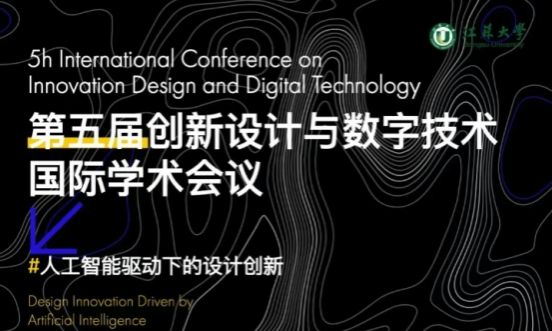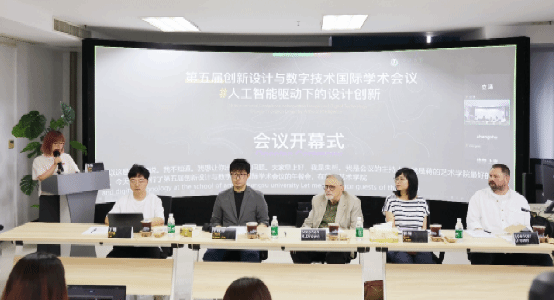On June 22,2025, the "5th International Conference on Innovative Design and Digital Technology (ICIDDT 2025)" was successfully held. Organized by Jiangsu University, hosted by its School of Arts, and guided by the Jiangsu Provincial Graduate Teaching Steering Committee for Art Studies, the event centered on the theme "Design Innovation Driven by Artificial Intelligence". Experts and scholars from institutions including City University of Hong Kong, Nanjing University of Aeronautics and Astronautics, San Jose State University, Purdue University, University of Idaho, George Mason University, University of Oregon, Washington State University, Hanyang University, Chung-Ang University, James Madison University, Augusta University, and Australia's Royal Melbourne Institute of Technology, along with international organizations such as Michael Quirk Studio, Landmark Columbus Foundation, and GREEN FOR L Korea, delivered insightful presentations and discussions through hybrid online-offline formats. Faculty and students from multiple universities worldwide attended the conference via the AEIC Academic Exchange Center's live streaming platform.

The conference comprised three segments: opening remarks, keynote presentations by experts, and student team presentations. The opening ceremony was chaired by Zhu Zhe, Vice Dean of the School of Arts. Attendees included distinguished guests such as Professor Stephen R.Drown (selected for the National Talent Introduction Program), Professor Guo Chen from James Madison University, Professor Qian Xuanzhen from Nanjing University of Aeronautics and Astronautics, Associate Researcher Ding Lu from Purdue University, and Spencer Drown, Project Manager of Michael Quirk Studio.
Vice President Zhu Zhe first expressed his warm welcome and heartfelt thanks to the domestic and foreign experts, scholars, teachers and students who participated in the academic forum. He hoped that teachers and students would listen to the comments and suggestions of experts, continue to deepen the education and teaching reform, and actively promote the frontier research of art design and artificial intelligence.

Following the opening remarks, Professor Stephen R. Drown, a distinguished expert selected for China's National Talent Introduction Program, and Professor Guo Chen from James Madison University in the United States delivered keynote speeches. They expressed their hope that this conference would serve as a global platform for cross-cultural, cross-regional, and interdisciplinary exchange of academic achievements and design practices. By exploring more scientific, creative, and practical applications and innovations in digital art design driven by artificial intelligence, the event aims to propel the future advancement of the design industry.
During the keynote presentations, Professor Qian Xuanzhen from Nanjing University of Aeronautics and Astronautics, Spencer Drown, Project Manager of Michael Quirk Studio in the United States, and Dr. Zhong Qi from Jiangsu University delivered insightful reports. Dr. Ding Lu, an associate researcher at Purdue University, served as the academic moderator.
Professor Chan Huanzhen delivered an academic presentation titled "Planning and Design of an Indonesian Innovative Design University in the AI Era." Against the backdrop of the AI-driven machine intelligence revolution, she proposed a strategic blueprint for Indonesia's innovative design university, aiming to cultivate talents who master both human intellect and AI collaboration. The framework is grounded in the theoretical framework of the Association of Cultural Landscapes of Asia (ACLA) and tailored to the unique characteristics of Malang City, Indonesia.
Manager Spencer Drown delivered an academic presentation titled 'Updates on the Seattle Little Saigon Site Park Project.' The conceptual design features low concrete retaining walls, artist entry installations, and accessible ramps, complemented by open-air lawns, mobile seating, and play areas. By incorporating biofiltration planting pathways, the project optimizes ecological environments while addressing the dual needs of safety and social interaction in community spaces.
Dr. Zhong Qi presented a research paper titled "Human-Machine Interface Design for Automotive Information Systems: Insights from Simulated Driving Experiments". The study demonstrated that dynamic auto-completion features enhance system usability and reduce driver distraction, while voice input outperforms traditional keyboard or handwriting methods. A 40×40mm handwriting input area was shown to effectively minimize visual deviation risks. These findings provide a safe and user-friendly solution for intelligent cockpit interaction design.
The postgraduate team presentations were academically moderated by Associate Professor Li Yingnan from Jiangsu University and Dr. Ding Lu, an associate researcher at Purdue University. Six research teams from Jiangsu University, City University of Hong Kong, and Korea University delivered thematic reports. Scholars and experts from domestic and international universities and organizations engaged in discussions and provided academic feedback on each presentation.
The first research team from Jiangsu University presented a scholarly report titled "Digital Development of Traditional Settlements in Suzhou Based on Landscape Genes". Addressing challenges in preserving Suzhou's traditional settlements, the team utilized the "Landscape Gene Theory" to digitally identify architectural and cultural elements of ancient villages like Mingyue Bay through 3D scanning, creating a visual model library. They proposed a three-phase strategy of "digitization, digital preservation, and intelligent revitalization", employing technologies like drone scanning to achieve digital preservation and activation. The findings have been applied in 3D animations and cultural experience products, providing a technical pathway for heritage preservation. On-site experts and online commentators including Professor Rula Awwad-Rafferty from the University of Idaho, Associate Professor Esteban Garcia Bravo from San Jose State University, and Professor Edgar Gabriel from George Mason University provided academic feedback on the presentation.
A research team from City University of Hong Kong delivered an academic presentation titled "Machine Learning-Based Urban Computing and Optimization Research". In the context of urbanization and digitalization, they proposed an integrated urban computing framework combining Generative Adversarial Networks (GANs) and Genetic Algorithms (GA) to tackle challenges such as crime prediction. Through GIS and remote sensing data modeling, the team achieved predictions of crime hotspots in New York, assessed pandemic risks in Shanghai, and created surface temperature maps. Their findings revealed that high albedo materials could reduce temperatures by 1.9°C while saving 11% energy. The results were applied to AI-assisted urban design, simulating the impact of traffic layouts on population movement to provide data-driven solutions for smart city management. On-site experts and online commentators, including Associate Professor Roberto Capecci, Professor Raffaella Sini, and Professor Kanghyun Lee from the University of Idaho, provided academic feedback on the presentation.
The second research team from Jiangsu University presented a study titled 'Hook Model-Based Interface Design for HSK Learning Applications.' To address the inadequate user experience in HSK learning apps, they integrated the Hook model into their design. Through analyzing behavioral data from seven mainstream apps and eye-tracking experiments, they identified 18 types of interaction issues. The team proposed enhancements to improve user engagement.